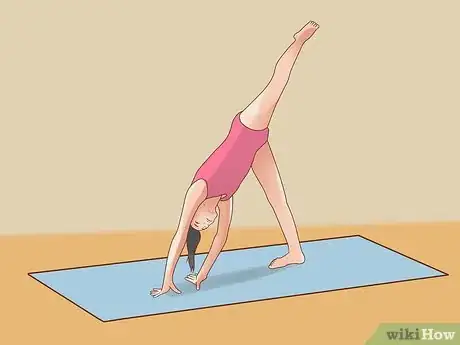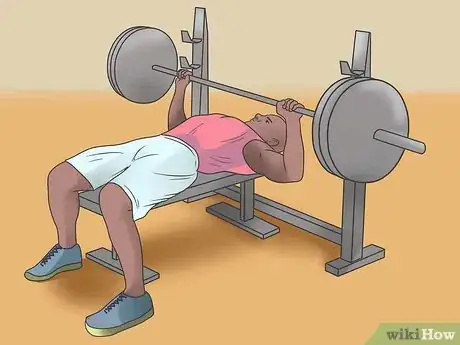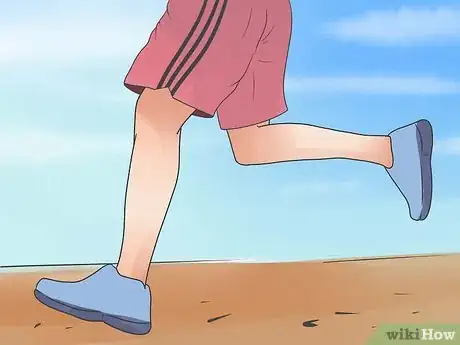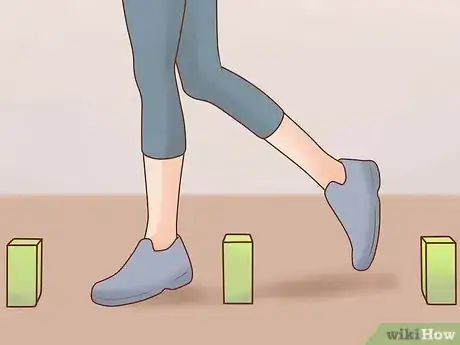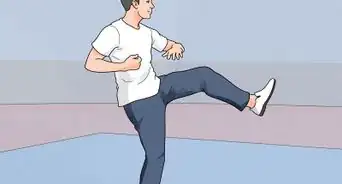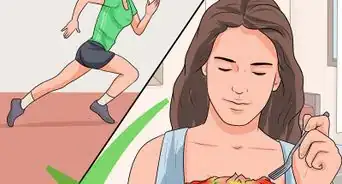This article was co-authored by Francisco Gomez. Francisco Gomez is the Head Coach at the FIT Potato Gym, a training gym established in 2001 in the San Francisco Bay Area. Francisco is a former competitive runner who helps endurance athletes train for major marathons like the Boston Marathon. Francisco specializes in Injury Rehab, Flexibility, Marathon Training, and Senior Fitness. He has a B.S. in Nutrition and Exercise Physiology & Running.
There are 20 references cited in this article, which can be found at the bottom of the page.
wikiHow marks an article as reader-approved once it receives enough positive feedback. In this case, 100% of readers who voted found the article helpful, earning it our reader-approved status.
This article has been viewed 266,144 times.
Agility refers to the quality of quickness or resourcefulness that can relate to your physical or mental abilities.[1] Being agile is not a natural trait, so you've got every chance of improving your ability. If you do the right things, you can quickly see improvements in both your physical and mental agility.
Steps
Improving Physical Agility
-
1Improve your balance. Practice balancing exercises to increase overall agility. This not only strengthens your muscles, it also helps focus your activity on a small scale.
- Try standing on one leg with your other leg out in front of you. After holding it for ten seconds, switch legs and do the same. You can also use a mirror to ensure that your legs are straight.
- Do handstands or cartwheels when you feel you've mastered beginner's balancing. These will help you improve your coordination as well as your balance.
- Make sure your weight is distributed evenly. You don't want to injure or strain certain areas when all your body should be working together.[2]
-
2Train with weights. There are multiple types of exercises that you can do that focus on different muscle groups. Work progressively, starting with handheld weights and moving to heavier weights as you build up strength.
- Do squats and deadlifts to strengthen the muscles in your legs and hamstrings. You can hold one hand weight in each hand while you perform the squat or deadlift, although deadlifts traditionally call for barbells. You can also use a barbell for squats. If you choose this option, place the barbell over your shoulder.
- You can do bench presses or other arm exercises. This increases your arm strength, which in turn will help you with activities such as throwing and catching.[3]
Advertisement -
3Perform cone taps. Place one cone in front of you. Lift one leg high, gently tapping the top of the cone with the ball of your foot before returning it to resting position. Repeat with the opposite foot. Switch back and forth for three sets of 30-second drills.
- This exercise strengthens feet muscles and ankles. It also makes you lighter on your feet and increases foot coordination.
- Try to not trip over the cone. If you find you are knocking over the cone, slow your movements down until you are no longer hitting the cone.
- Once you've mastered this exercise at one level, increase your speed to gain more skill and balance. You can also add more 30 second repetitions.[4]
-
4Do ladder drills. Using an agility ladder, which is about 10 yards (9 m) long with 18 inch (45.7 cm) blocks, run through each rung of the ladder slowly. On each step, pump your arms high and bring your knee up to your chest, changing arms and legs as you make your way through the ladder. Once at the end of the ladder, return to where you started to complete one drill.
- Complete each drill you perform 2 to 4 times, increasing repetitions once as you get better at them. You can also increase your speed as you improve.
- If you do not have an agility ladder, you can create your own with sticks and string or with tape.
- As an alternative, try this exercise going sideways instead of forward. Jump sideways between rungs before lifting your leg and arm as you do in the original exercise.[5]
-
5Run suicide runs. Start by running about 20 feet (6 m) away. As soon as you reach that point, turn around and run back to where you began. Without stopping, turn around and run 30 feet (9.1 m) away, then return back to start. Finally, without stopping, turn and run 40 feet (12.2 m) away, then return back to start.
- Complete multiple cycles of these runs for the best results. You can also extend the distance once the initial runs become too easy for you.
- These are great ways to improve your strength, speed, balance, and precision. Do these a few times a week to fully see the benefits.[6]
-
6Jump hurdle drills. Set up a 5-10 count row of 6 or 12 inch (15.2 or 30.5 cm) hurdles in a straight line. Starting beside the first hurdle, jump over it with your first leg, pausing for a few seconds before you drop your other leg to stand in between the first two hurdles. Jump back over the first hurdle, returning to start. After this, repeat the same lateral jump across block 1 and then block 2 before moving back to start. Follow the same pattern for all the blocks, jumping over all of the hurdles before returning to start. Repeat with your other side, turning around and leading with your opposite leg.
- Once you have mastered this, try increasing your speed over the hurdles, removing the pause in between each jump.
- Instead of hurdles, you can use cones, yoga blocks, or any 6 to 12 inch (15.2 to 30.5 cm) object you have on hand. Just make sure it is in a shape that is easy to jump over and that won't cause injury.[7]
- If you are just beginning, try the 6 inch (15.2 cm) first. If that is still too tall, try a smaller object or simply jump imaginary hurdles in the air. After completing a few weeks of this exercise, you can add additional height.
- The purpose of these types of drills is to increase your balance and stride length. This will help you improve your performance in sports such as tennis, soccer, and football.[8]
Improving Your Mental Agility
-
1Eat the right breakfast foods. Waking up each day with a diet full of vitamins, minerals, and antioxidants can boost your mental capacity over time. There is also the added benefit of increasing your immune system and improving your health.
- Choosing a hard-boiled egg rich in choline, which is type of B vitamin, can increase your verbal and visual performance.There is also a recent study that links this vitamin to a decrease in dementia.[9]
- Eat foods rich in zinc, such as bran cereal. Zinc plays a pivotal role in cognitive stability and memory formation. There is also the bonus effect of improving your skin tone.[10]
- Eat antioxidant-rich fruits and vegetables. They provide your brain with necessary nutrients that they may not be receiving from other things in your diet. They help increase mental capacity and memory.[11]
- A small amount of caffeine first thing in the morning from a cup of coffee or caffeinated tea can help improve your mental performance and memory as well as increase your concentration.[12]
-
2Exercise during the day. You can do a short workout at any point during the day to increase mental performance. It also helps with mental health and agility by reducing stress, boosting mood-improving chemicals in your brain, relieving anxiety, increase relaxation, and increasing creativity.[13]
- Doing exercises such as aerobics releases vital neurotransmitters that increase concentration levels and brain power as well as help you focus. [14] Cardiovascular workouts can also increase the production of brain cells in your hippocampus, which is the part of your brain that is responsible for learning and memory.[15]
- You can go for a brisk walk, a jog, or a run if you prefer to be outside. If you prefer the indoors or in harsh weather conditions, use a stationary bike or treadmill. Do these exercises for 45-60 minutes, four days a week.[16] Not only will it help your mental state, it will also help with physical agility as well.
-
3Read more. Whether it's the latest thriller, a classic novel, or your favorite magazine, reading engages many parts of your brain linked with memory, cognition, and imagination. Your brain imagines environments and people and your brain supplies voices for dialogue. Even with simple sentences, your brain must recall meanings of words and concepts, encouraging brain development. Reading also improves mood and increases relaxation.[17]
- Pick any type of reading that most excites you. As long as you are engaged and enjoying it, your mind will be engaged.
-
4Play games. Whether it's a video game or a traditional mind puzzle, games test multiple skills and opens neural pathways. Choose those games that require skill and multiple levels of cognition to help improve focus and memory retention. Play the game a few days a week to engage your mind and increase your cognition.
- You can complete Sudoku, crossword puzzles, or other games that test your reasoning skills to keep your mind agile. Also try trivia based games to build your brain muscles and improve memory.[18]
- Even if you are older with no previous experience or not a huge gamer, pick a video game that you can enjoy, such as a driving or puzzle game. This will give you a sense of entertainment while improving your mental capacity as well.[19]
- There are also online platforms such as Luminosity.com that provide a multitude of games to increase mental agility. Luminosity bases their games of scientific research and tailors the games you play to the areas of your mind that you want to improve.[20]
-
5Learn something new. Learn a new way to complete your normal routine and your everyday tasks You can also pick up a new instrument, learn a new language, travel to new places, or even eat new foods. These tasks help your brain create new neural pathways.[21]
- Difficult, new tasks increase brain function and memory retention. This works your brain in new ways and reaches unfamiliar mental territory.[22]
-
6Collaborate with others. Whether it is at work or at home, work with other people on projects. This gets you out of your familiar mindset and forces you to work with other people in mind. Try seeing the project from their point of view or incorporate their ideas into your own. This encourages you to see something in a new way and approach it from a different angle, which helps keep your brain quick.[23]
Agility Drills and Workouts
Expert Q&A
Did you know you can get expert answers for this article?
Unlock expert answers by supporting wikiHow
-
QuestionWhat is the best exercise for agility?
 Francisco GomezFrancisco Gomez is the Head Coach at the FIT Potato Gym, a training gym established in 2001 in the San Francisco Bay Area. Francisco is a former competitive runner who helps endurance athletes train for major marathons like the Boston Marathon. Francisco specializes in Injury Rehab, Flexibility, Marathon Training, and Senior Fitness. He has a B.S. in Nutrition and Exercise Physiology & Running.
Francisco GomezFrancisco Gomez is the Head Coach at the FIT Potato Gym, a training gym established in 2001 in the San Francisco Bay Area. Francisco is a former competitive runner who helps endurance athletes train for major marathons like the Boston Marathon. Francisco specializes in Injury Rehab, Flexibility, Marathon Training, and Senior Fitness. He has a B.S. in Nutrition and Exercise Physiology & Running.
Fitness Coach
-
QuestionHow can I improve my speed as a badminton player?
 Michele DolanMichele Dolan is a BCRPA certified Personal Trainer in British Columbia. She has been a personal trainer and fitness instructor since 2002.
Michele DolanMichele Dolan is a BCRPA certified Personal Trainer in British Columbia. She has been a personal trainer and fitness instructor since 2002.
Certified Fitness Trainer
-
QuestionHow long does it take to see a big change in my agility?
 Michele DolanMichele Dolan is a BCRPA certified Personal Trainer in British Columbia. She has been a personal trainer and fitness instructor since 2002.
Michele DolanMichele Dolan is a BCRPA certified Personal Trainer in British Columbia. She has been a personal trainer and fitness instructor since 2002.
Certified Fitness Trainer
wikiHow Video: How to Improve Your Agility
References
- ↑ http://www.merriam-webster.com/dictionary/agility
- ↑ http://news.bbc.co.uk/sportacademy/hi/sa/in_the_gym/workouts/newsid_3160000/3160287.stm
- ↑ http://www.bodybuilding.com/fun/wotw72.htm
- ↑ http://www.fitness19.com/improve-your-agility-with-these-5-exercises/
- ↑ http://www.brianmac.co.uk/agility.htm
- ↑ http://news.health.com/2014/08/01/4-fat-burning-exercises-that-improve-your-agility/
- ↑ http://www.acefitness.org/blog/3782/6-exercises-to-improve-agility
- ↑ http://www.active.com/fitness/articles/5-agility-drills-to-boost-speed-and-improve-your-fitness
- ↑ https://www.ncbi.nlm.nih.gov/pmc/articles/PMC3428233/
- ↑ https://www.ncbi.nlm.nih.gov/pubmed/29572039
- ↑ https://www.ncbi.nlm.nih.gov/pubmed/29719199
- ↑ http://www.agingcare.com/Articles/Improve-brain-function-agility-memory-in-elders-133301.htm
- ↑ http://www.huffingtonpost.com/2013/03/27/mental-health-benefits-exercise_n_2956099.html
- ↑ http://www.medicaldaily.com/ways-naturally-improve-your-focus-all-day-long-morning-night-249371
- ↑ http://www.huffingtonpost.com/2013/03/27/mental-health-benefits-exercise_n_2956099.html
- ↑ http://www.oregonlive.com/health/index.ssf/2010/01/aerobic_training_boosts_aging.html
- ↑ http://www.healthline.com/health/depression/mental-fitness#2
- ↑ http://www.healthline.com/health/depression/mental-fitness#2
- ↑ http://www.npr.org/blogs/health/2013/09/10/218892225/multitasking-after-60-video-game-boosts-focus-mental-agility
- ↑ http://www.lumosity.com/
- ↑ http://www.healthline.com/health/depression/mental-fitness#2
- ↑ http://metro.co.uk/2013/05/17/5-ways-improve-mental-agility-better-job-prospects-3812210/
- ↑ http://www.commscope.com/Blog/The-Surefire-Way-to-Mental-Agility/
- ↑ http://www.active.com/fitness/articles/5-agility-drills-to-boost-speed-and-improve-your-fitness
- ↑ http://www.active.com/fitness/articles/5-agility-drills-to-boost-speed-and-improve-your-fitness
- ↑ http://www.bodybuilding.com/fun/wotw72.htm
About This Article
To improve your agility, start with a simple balancing exercise by standing on one leg and raising the other in front of you for 10 seconds. After you’ve mastered this, try doing suicide runs to build your stamina by running to a fixed point and back. Then, practice jumping hurdles as this will help you improve your stride length and position control. All of these exercises require strength, so try combining them with some weight training exercises, like squats. For tips on strengthening your mental agility, including what to eat for breakfast, keep reading!
